![]()
![]()
Recovering Memory. Recovering Dignity
It was 25th March, night. A Pakistani officer accompanied by soldiers entered their Dhaka University flat, dragged out Meghna’s father and and shot him. Jyotirmoy Guhathakurta was a well-known academic. He bled to death slowly, five days later. As he lay dying in Dhaka Medical College Hospital with a bullet wound in his neck, surrounded by doctors too scared to treat him, he repeatedly told Bashanti, his wife, you must write. Write what? History, he replied. But I don’t know how to write history. Well, write literature then.
 Jyotirmay Guhathakurta and Basanti Guhathakurta with seven year old daughter, Meghna and nephew Kanti in Gandaria, Dhaka, 1966. Bangladesh. ? Bazle Mawla
Jyotirmay Guhathakurta and Basanti Guhathakurta with seven year old daughter, Meghna and nephew Kanti in Gandaria, Dhaka, 1966. Bangladesh. ? Bazle Mawla
I met Meghna in 1973, the year we started college. Later we went to Dhaka University together. As we became the closest of friends, I learnt that she would lie in bed each night and recollect the horror of that night in 1971. I would tell myself, I have to remember each incident, what happened, what followed. I must not let myself forget. Many years later, I remember asking her, “Megh, do you still do that? Re-collect each scene, each incident…?” “Yes, each night, after turning out the lights, I lie in bed and remember what happened, as it happened,” was her reply.
It is important to recover memories. To tell oneself that the world was not born this moment, to remind ourselves that we have long histories. Or else, says Uruguyan novelist Eduardo Galeano, we will become like the peoples of Chicago who do not know of the Haymarket martyrs, or that the First of May was born in Chicago. Galeano writes, Chicago has “deleted” the memory of International Workers Day, a day that is both a tragedy and a fiesta, a day celebrated the world over, one that affirms the right of the workers to organise. Our histories are both of betrayal, and dignity. We need to recover both.
The Gift of a Sewing Machine
Adivasi activist Choles Ritchil was returning from a wedding on March 18, 2007 when his microbus was stopped. He was arrested by half a dozen plainclothes men, and taken to Khakraid army camp. Choles, alongwith other Mandi families of Modhupur forest, were opposed to the eviction of 25,000 Mandi peoples from the forest through the government scheme (2003) to construct an eco-park. Despite Mandi opposition, Forest department officials began constructing a high wall that would section off 3,000 acres of forest land. In January 2004, police fired on peaceful Mandi protestors killing Piren Snal, and injuring 25 others. Public outrage at police brutality helped shelve eco-park plans, but Forestry officials later filed 20 false cases against the Mandis. Choles, widely-respected and prominent, was implicated in these cases.
 Choles Ritchil. Photographer unknown
Choles Ritchil. Photographer unknown
At Khakraid, Choles was tied to the grill of a window, and beaten mercilessly. Then his torture began. The next day, police officials handed over his dead body to relatives. In accordance with religious custom, his body was bathed before burial. Those who did so said that it bore horrific signs of mutilation. Photographs, hurriedly taken, serve to document the marks of torture.
 Mutilated body of Choles Ritchil. Photographer unknown
Mutilated body of Choles Ritchil. Photographer unknown
Nearly seven months later, on October 10, members of the Joint Forces arranged a small ceremony in the Tangail Upozilla office. Choles’ first wife Sandhya Rani Simsang was given cash, a sari and a sewing machine. His second wife Serpina Nokrek was also given cash, a sari and a sewing machine.
A sewing machine is said to signify connections. It connects the needle to the thread, stitches together separate pieces of cloth into a whole. But what does this sewing machine, born of torture and a mutilated body, connect? Mandi women’s eviction from the forest has also meant their eviction from indigenous traditions of weaving and sewing, traditions embedded in a matrilineal culture, says Pavel Partha*, an ethno-botanist and an impassioned researcher. The state has torn the lives of Mandi women away from Modhupur forest-which-is-their-culture. The extra-judicial killing of Choles Ritchil has torn to pieces the lives of Sandhya Rani, Serpina Nokrek, and their respective children. Tears that no sewing machine can repair.
They say torturers often wear hoods. They shy away from eye contact with their victims. A last vestige of humanity? Maybe. And if so, it certainly offers us crumbs of hope.
What happened at the Tangail gift-giving ceremony? Did the gift-givers look Sandhya and Serpina in the eye? How on earth did they get conscripted into the whole affair? Were they obliged to attend, to receive? Maybe those directly involved in Choles’ death were not present. After all, six army and civilian personnel, including Major Toufiq Elahi and Tangail Forest department official Abu Hanif Patwari were transferred soon after the death. A one person investigation committee consisting of a judge was also set up (has the report been completed, submitted? No one seems to know). The point I wish to make is that the institutional nexus — army camp, Forest department, thana, doctors, union council officials — within which Choles’ (and other adivasi) deaths have taken place, remains intact. That the gift-giving ceremony — an official event, funded by the public exchequer — took place within this nexus. The circumstances surrounding Choles Ritchil’s death is known to all, Mandi and Bengali alike. Pretences must have been necessary to pull off the ceremony. The presence of members of the Joint Forces, civilian administrators, elected representatives of the former goverment at the local level, professionals etc etc must have shored up those pretences.
I look forward to the Freedom of Information Act. I want to be able to read official files that contain an order to pick someone up. I want to know the language in which torture is camouflaged. I want to know the names of doctors who sign death certificates, the causes that are listed (death due to, surely not eyes plucked, testicles removed, anus mutilation, removal of fingernails). I want to know how Forest officials are able to construct false cases implicating those who protest against the injustice of eviction.
We need to know more about the rules of governance to weave tapestries of resistance across ethnic divides.
Rangs building: The death of cchotolok workers
Not all bodies have been recovered from the Rangs building. Not yet. Two or three remain. A faint smell of death, of decomposed flesh, still hangs over the fourth floor area.
The bodies of all Sidr cyclone victims have not been recovered either, one keeps coming across newspaper reports of a child’s body found in a paddyfield, a father’s body being identified by his son. But that, I feel, is different. Difference hinges partly on the word nature, a word, that I admit needs to be re-thought in the context of global warming since ‘natural’ disasters are no longer natural.
Rangs is a profoundly urban disaster. Compounded by the fact that the hapless workers who died come from villages, the stories that frame their migration, ‘they came to the city in search of work’ hide continued urban enrichment at the cost of villages. Images haunt me as I read what is written in the newspapers: it happened in five seconds, the roofs came tumbling down, they do not give us our dead, I cannot go off with my brother’s dead body, there are others from Modhukhali, their mothers and sisters and wives are waiting too. My two brothers got buried in the rubble. They are no longer alive. They must have died.
 Cleaners clearing debris outside the Rangs Building to make way for traffic. Early hours of the morning. 8th December 2007. Dhaka. Bangladesh. ? Zaid Islam
Cleaners clearing debris outside the Rangs Building to make way for traffic. Early hours of the morning. 8th December 2007. Dhaka. Bangladesh. ? Zaid Islam
 Demolition workers who have set up their own emergency team, warm themselves at night. 8th December 2007. Dhaka. Bangladesh. ? Zaid Islam
Demolition workers who have set up their own emergency team, warm themselves at night. 8th December 2007. Dhaka. Bangladesh. ? Zaid Islam
I piece together the names of the dead. The names are scattered. Some crop up in the newspapers when bodies found are identified: Amirul 26, Zillur 24. Farid Mian. In other places, names of missing relatives mentioned by surviving workers. There are so many: Farid Sheikh, Delwar Sheikh, Jiru Molla, Kaijar Molla, Jahid Molla, Ruhul Amin, Mannan Shikdar, Abdur Rahim Sheikh, Daud Munshi, Jiblu. They are mentioned in passing, as if attached to bodies, to morgue identifications. A few days later, some more names. Some missing have now been found dead: Farid Mian 26, Zero Molla 25, Kaiser Molla 26, Mannan Sikder 35, Daud Munshi. A day later, another name, Abdur Rahim. Again very young, only twenty five. But, I think, what about Jahid, Jiblu, Firoj? A news item catches my eye: the Rangs group claims that security guard Shahid’s body is buried beneath the rubble. Four. It’s been nearly three and a half weeks now.
 The still fingers of an unidentified worker. The bodies of three demolition workers were found on the morning of the 9th December 2007. Rangs Building. Dhaka. Bangladesh. ? Zaid Islam
The still fingers of an unidentified worker. The bodies of three demolition workers were found on the morning of the 9th December 2007. Rangs Building. Dhaka. Bangladesh. ? Zaid Islam
I cannot imagine the extent of the nightmare for family members who have been wandering about in the rubble of Rangs Bhaban, looking for traces of their beloved, maybe a pillow, the corner of a lungi, a shirt sleeve. Priscilla Raj, independent journalist, had written of an elderly, bearded man, standing outside Rangs, bitterly saying, “We are cchotolok, why should anyone bother?” He was right. No one did. There was no moddholok collective presence outside the building, no strong suport for Nirman Sromik Union’s demand that compensation for the dead be four lakh taka, not one. Dhaka’s moddholok, no doubt horror-struck, were witnesses to the disaster from a distance made safe by television and print media. I myself and many others were outside the National Museum. We were protesting archaeological artifacts being sent to Guimet. Those who joined in the wake outside the Rangs building were people like those dead or missing, part of the urban dispossessed. They witnessed grief at close quarters.
In this city’s landscape, the history of Rangs workers will be one of dignity. And ours that of betrayal.
Rahnuma Ahmed
New Age. 2nd January 2008
————————————–
*Pavel Partha, “Odhipoti Shelai Machine O Fali Fali Shalbon” (A Dominant Sewing Machine and Rows of Shal Trees), unpublished.
Tag: Workers
It Should Not Have Happened
![]()
Why should the poor always have to pay for the misdeeds of the government, of the rich?
This question surfaced yet again when I stood outside Rangs building on the morning of Dec 12.
Rangs, one of the largest business houses in Bangladesh, had their building plans approved by Rajuk (Rajdhani Unnoyon Kortripokkho, i.e., Capital Development Authority), and they built a huge edifice. Approval for high rises are generally not given in this area due to flight restrictions. Six storied buildings are the limit. However, Rangs built a 22 storied building which no one could miss. Except Rajuk, of course.
That is how things stood until the present caretaker government came into power and rushed headlong into its drive against corruption.
? Which officials in Rajuk had okayed these plans? And why? That has remained a secret. Has anyone in Rajuk been punished for approving these plans?
? The Supreme Court ordered the demolition of the building, and Rajuk appointed Six Star, a ship-breaking company to carry out the work. Who made the decision? On what basis? What qualifications did Six Star have? Was any corruption involved? If so, will those involved be tried?
? After the demolition disaster, Six Star, Rajuk, Rangs — will they be made accountable for their misdeeds?
Is a life worth only one lakh taka — the sum that the government will pay as compensation for those who have died?
‘They don’t give us our dead’
An elderly man sat 50 feet away from the Rangs building on a second floor veranda of a shopping market. After the innards of the building had collapsed, many workers had taken shelter in this veranda. The elderly man had come to Dhaka early this morning with his son-in-law, in search of his son’s body. He muttered something when I asked him if he had spoken to anyone here. I couldn’t make sense, and repeated my question. I could barely make out what he said, “They don’t give us our dead.” He told me he had come from Gaibandha, and I thought to myself, now we can be sure that one of those who have died is from Gaibandha.
A woman has rushed over from Modhukhali. Her brother has suffered a head injury. But thankfully, he is alive, and he will live. At least ten people from Modhukhali are thought to have died in the demolition disaster.
Hajari, one of the workers hired for demolition said, one of the building’s security men is missing. He had last been seen on one of the topmost floors of the building. “It all happened in less than 30 seconds.” Hajari and the other workers had scrambled down the floors to save themselves.
I spoke to some of the workers and it seemed that no one from Rajuk or Six Star, at least not any one in a position of authority had contacted them, or spoken to them, let alone reassured them. Class distances are such that the workers themselves had not gathered the courage to talk to Rajuk officials.
Six Star company, Hajari told me, had brought the main group of workers from Chittagong. Being a port city, Chittagong is a place where people from different parts of the country migrate to in search of work. Hajari’s home is Barisal but he has lived for many years in Chitagong. “Six Star,” he said, “they will provide compensation. They are ever-ready. In Chittagong dock, every month you get to see one or two workers die, such accidents keep happening.” Most of those who had survived the Rangs disaster had been sent back by Six Star. Only 50 workers had been kept back for the rescue effort.
Six Star was paying the workers daily wages and also providing meal charges. From tonight (Dec 12) , the company would also arrange workers’ boarding. This is what Hajari had told me but when I spoke to two other workers, they said they were not being paid their regular wages. Neither were labour shordars giving them money to buy food.
On the market verandah I came across another worker, who was released yesterday from Dhaka Medical College. He had received back injuries, so said the hospital slip. He did not have the money to buy the medicine that had been prescribed. Painkillers on an empty stomach would do him more harm than good. He told me that he had slept on a thin sheet of cloth the night before, and that his pain had increased.
An old story of anguish and suffering
As we talked with the workers and their relatives, I noticed an elderly, bearded man speaking nearby. He was noticeably agitated. I took him to be a demolition worker. I moved closer to where he stood and heard him say, “If they had been the sons of MPs and Ministers, would the dead bodies have been left hanging? People would have been running around breathlessly. We are cchotolok, why should anyone bother?” I later found out that he didn’t work for Rangs, that he worked somewhere else nearby. Listening to him was like listening to a broken record. I was reminded yet again of how helpless poor people are.
It should not have happened. It should not have been allowed to happen. It is something that should have caused a government’s downfall. It is amazing that such things keep happening. Almost daily. And ceaselessly.
Newspaper reporting
At home, we read Prothom Alo. In terms of reporting, it is one of the finest newspapers in the country. I quickly skimmed the reportage on Rangs, once again today. None of the reports focus on who is to blame for the disaster, they tend to highlight the accident-al nature of the disaster. I see an editorial, but I do not have the time to read it. Those who read other newspapers will know how it has been reported in other dailies. Some may cite cyclone Sidr, or the harassment of university teachers as reasons for such reporting but I find it difficult to agree. I think the un-focused reporting is deliberate.
But I must not be too harsh. After all, it is news reporters who keep the story alive as those who are guilty hide behind screens of authority.
People’s distrust
Tonight I have learnt that 14 coffins have been taken inside. Since then, family members of the workers have refused to leave the area. Many of them think that the authorities will get rid of the bodies. They have come from outside Dhaka, they do not belong here, they have no networks of familial or social support in this city. They can only gather and resist with whatever they have.
Will the authorities really get rid of the dead bodies? Will they not hand over to grieving family members the bodies of their beloved ones? You may think I am jumping to conclusions but it is true that the whole process is shrouded in secrecy, and that those in authority are trying to save their skin.
Yesterday afternoon as I stood outside Rangs Bhaban, I could catch the faint smell of decomposing bodies. The smell will get stronger. Fire Brigade workers, who are on standby, do not know when rescue efforts will begin.
I belong to the ranks of the ordinary people, I belong to those who are toothless and clawless. Yet I cannot help but think, those who are guilty must not be allowed to get away. At least, not this time.
Priscilla Raj
1:00 am
Dec 13, 2007
[translation: rahnuma ahmed]
Bangladeshi journalists Priscilla Raj and Saleem Samad, who had worked for the Channel 4 team as interpreter and fixer, respectively, were also detained and charged with involvement in ?anti-state activities.? Raj was released on bail in December 2002.
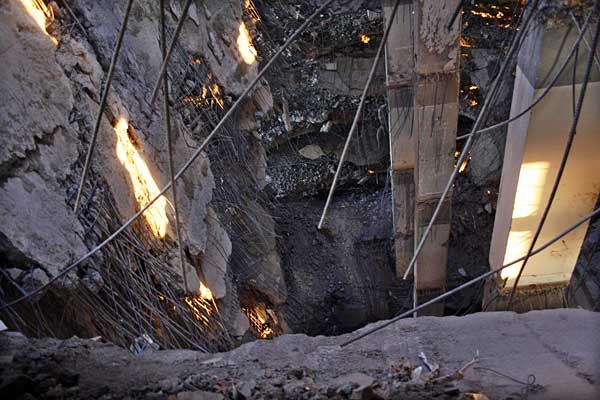 Collapsed floor of Rangs Building. December 9. 2007 ? Munir uz Zaman/DrikNews
Collapsed floor of Rangs Building. December 9. 2007 ? Munir uz Zaman/DrikNews
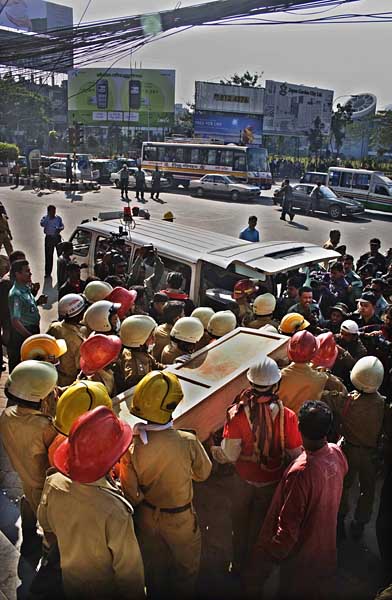 Body released by Fire Brigade being sent to morgue. ? Azizur Rahim Peu/DrikNews
Body released by Fire Brigade being sent to morgue. ? Azizur Rahim Peu/DrikNews
We rushed as soon as we received the tip off, sneaking away from our workshop on “Investigative Journalism for Television.” Working our way round the devotees praying on Panthapath we rushed to the National Museum.
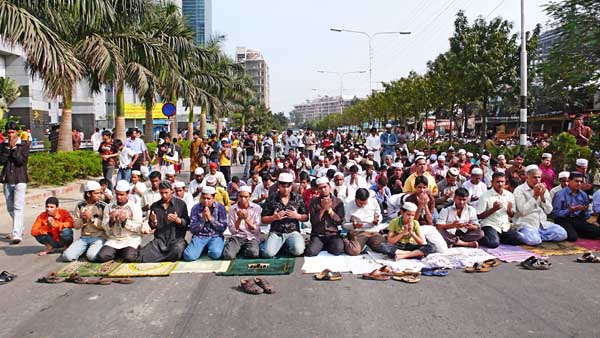 Jumma prayers on Panthapath. Friday December 7. 2007. ? Shahidul Alam/Drik/Majority World
Jumma prayers on Panthapath. Friday December 7. 2007. ? Shahidul Alam/Drik/Majority World
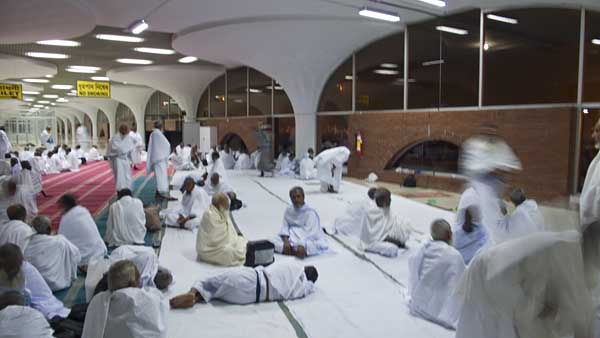 Hajis at Zia International Airport. Saturday December 8. 2007. ? Shahidul Alam/Drik/Majority World
Hajis at Zia International Airport. Saturday December 8. 2007. ? Shahidul Alam/Drik/Majority World
It was a false alarm. The trucks had left, and the artefacts that were still left in the National Museum were safe. At least for the moment. The remaining week, my book launch in Glasgow,
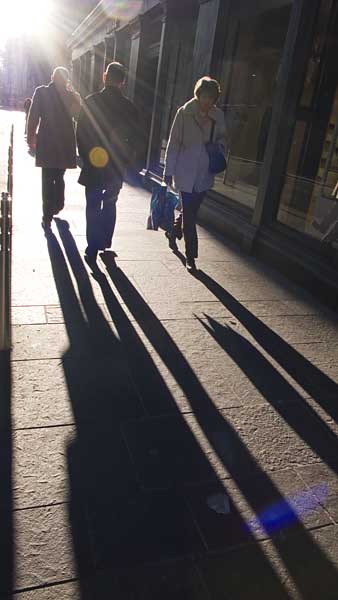 Glasgow. December 10 2007. ? Shahidul Alam/Drik/Majority World
Glasgow. December 10 2007. ? Shahidul Alam/Drik/Majority World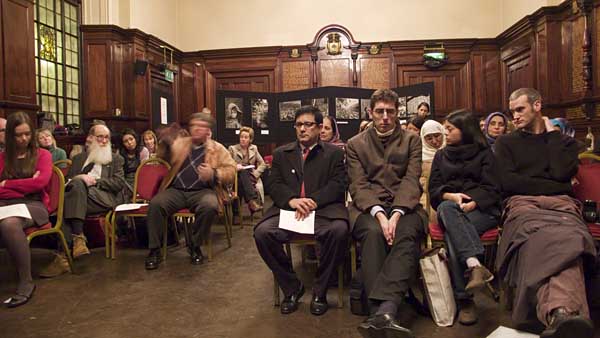 Glasgow. December 10 2007. ? Shahidul Alam/Drik/Majority World
Glasgow. December 10 2007. ? Shahidul Alam/Drik/Majority World
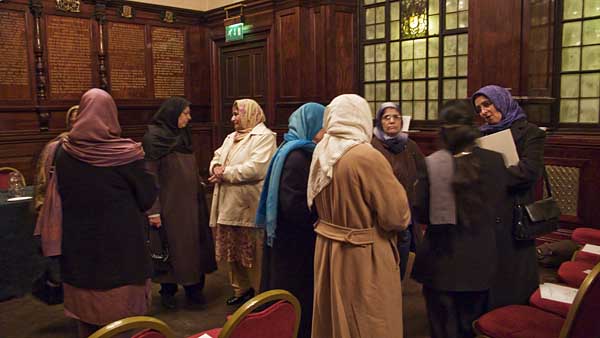 Glasgow. December 10 2007. ? Shahidul Alam/Drik/Majority World
Glasgow. December 10 2007. ? Shahidul Alam/Drik/Majority World
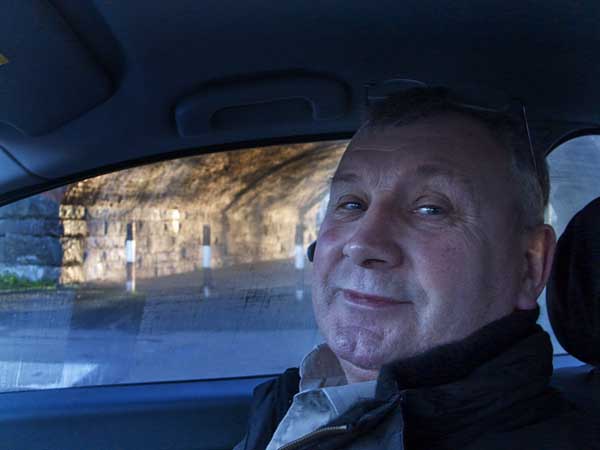 Taxi driver Robert who had worked at Port Glasgow. Ships later taken apart in Chittagong, Bangladesh, started their journey here. December 10 2007. ? Shahidul Alam/Drik/Majority World
Taxi driver Robert who had worked at Port Glasgow. Ships later taken apart in Chittagong, Bangladesh, started their journey here. December 10 2007. ? Shahidul Alam/Drik/Majority World
the Prince Claus Fund Award ceremony in Amsterdam and the conference “Visible Rights” at Harvard, took me from a sunny afternoon in Scotland to the snow covered streets of Cambridge.

Though Jon Husband had helped me setup my blog, I had never met him before. Jeroen picked me up at Schipol, and Jon, Jeroen and I had dinner at the Bazar Middle Eastern restaurant in Amsterdam. December 10. 2007. ? Shahidul Alam/Drik/Majority World
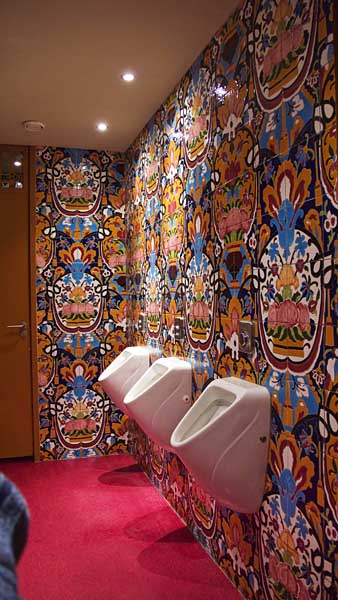 The ornate loo at the Bazar Middle Eastern restaurant in Amsterdam. December 10. 2007. ? Shahidul Alam/Drik/Majority World
The ornate loo at the Bazar Middle Eastern restaurant in Amsterdam. December 10. 2007. ? Shahidul Alam/Drik/Majority World
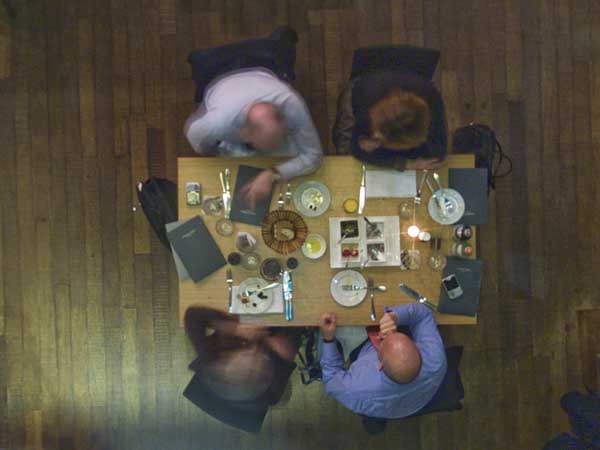 Diners seen through the glass floor at Muziekgebouw. Amsterdam. Dec 12. 2007. ? Shahidul Alam/Drik/Majority World
Diners seen through the glass floor at Muziekgebouw. Amsterdam. Dec 12. 2007. ? Shahidul Alam/Drik/Majority World
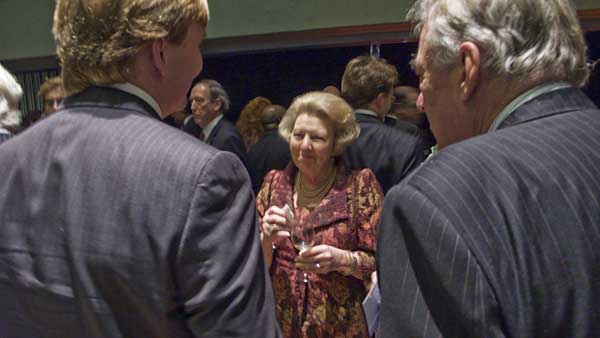 Queen Beatrix at Prince Claus Fund Award Ceremony at Muziekgebouw. Amsterdam. Dec 12. 2007. ? Shahidul Alam/Drik/Majority World
Queen Beatrix at Prince Claus Fund Award Ceremony at Muziekgebouw. Amsterdam. Dec 12. 2007. ? Shahidul Alam/Drik/Majority World
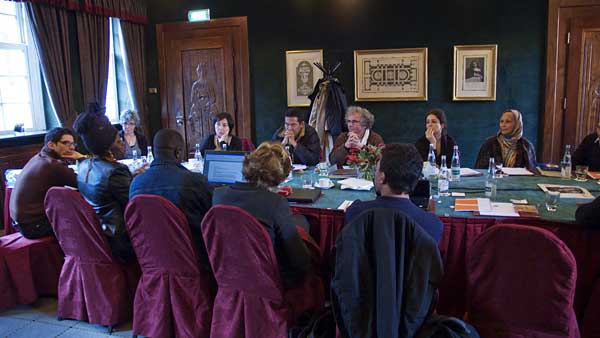 Network meeting of Prince Claus Fund at Grand Hotel, Amsterdam. December 13th 2007. ? Shahidul Alam/Drik/Majority World
Network meeting of Prince Claus Fund at Grand Hotel, Amsterdam. December 13th 2007. ? Shahidul Alam/Drik/Majority World
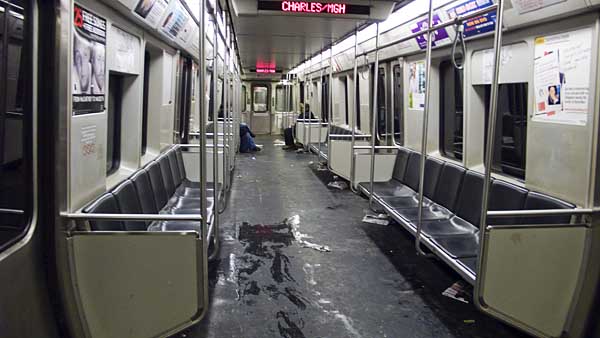 Train at Boston December 14. 2007. ? Shahidul Alam/Drik/Majority World
Train at Boston December 14. 2007. ? Shahidul Alam/Drik/Majority World
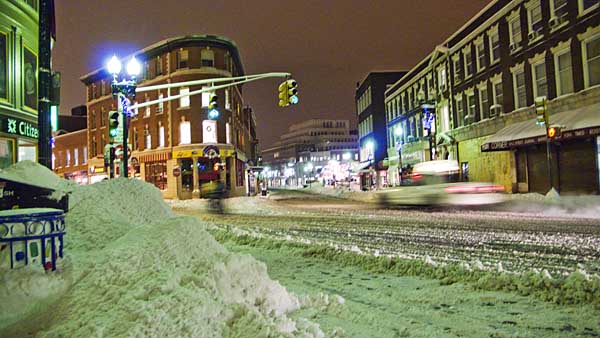 Outside Harvard train station at 2:00 am. December 14. 2007. ? Shahidul Alam/Drik/Majority World
Outside Harvard train station at 2:00 am. December 14. 2007. ? Shahidul Alam/Drik/Majority World
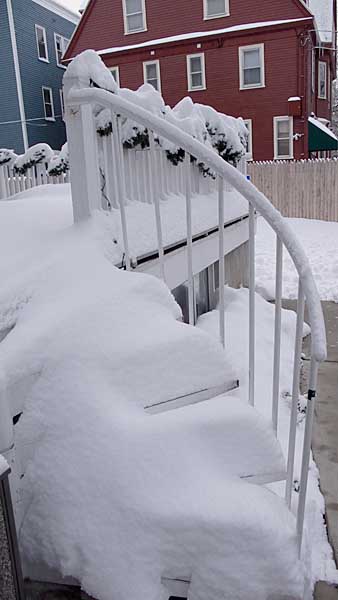 Stairs at Irving House. December 14. 2007. ? Shahidul Alam/Drik/Majority World
Stairs at Irving House. December 14. 2007. ? Shahidul Alam/Drik/Majority World
There was good news in between. The Rajshahi University teachers being released was a great relief, but the deaths of workers at Rangs Building, and the slum fire in Begunbari reminded me how far my own life was from the reality of workers and slum dwellers of my land.
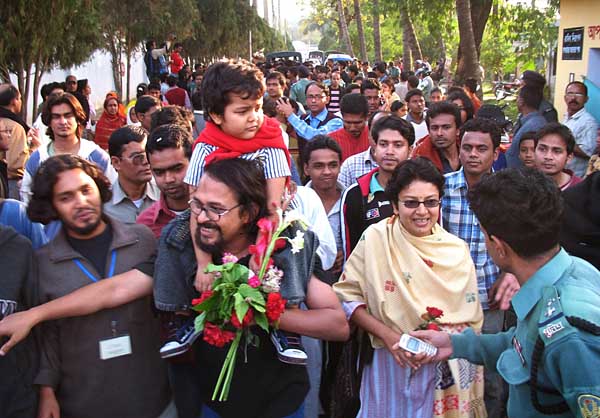 Detained Rajshahi University teachers, released after being granted a presidential pardon. December 10. 2007. ? Iqbal Ahmed/DrikNews
Detained Rajshahi University teachers, released after being granted a presidential pardon. December 10. 2007. ? Iqbal Ahmed/DrikNews
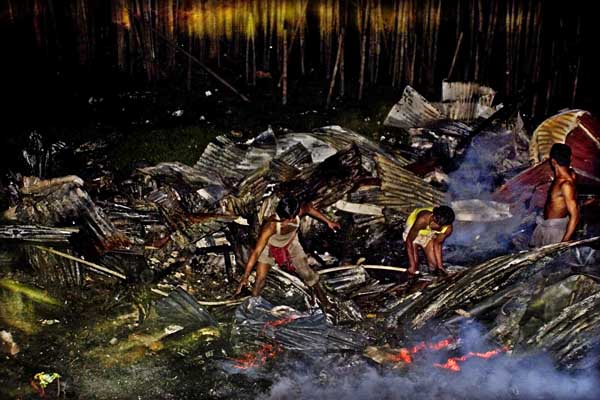 Fire in Begunbari slum. December 15. 2007. ? Zaid Islam/DrikNews
Fire in Begunbari slum. December 15. 2007. ? Zaid Islam/DrikNews
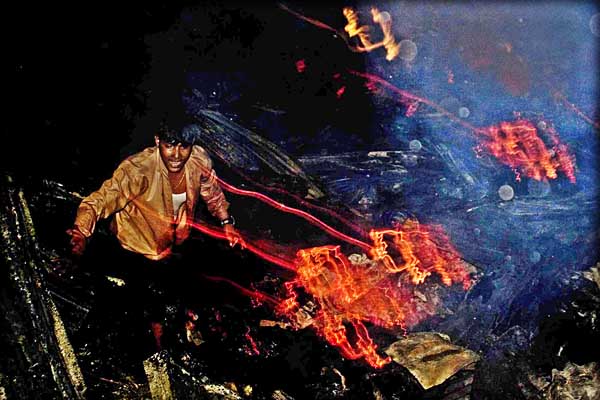 Fire in Begunbari slum. December 15. 2007. ? Zaid Islam/DrikNews
Fire in Begunbari slum. December 15. 2007. ? Zaid Islam/DrikNews
While the gatekeepers who rule our land remain untouched by the death of the poor. While media houses remain in the hands of wealthy business people. While opulent adverts by Grameen, Banglalink and Warid influence what gets reported in mainstream, the lives of media professionals like Priscilla Raj, Tipu Sultan, Probir Shikdar and Tasneem Khalil will continue to be under threat, The war criminals supporting the Pakistan Army had killed our intellectuals on the month of victory in 1971. December has another meaning for the workers and the slum dwellers who live under different military rulers.
